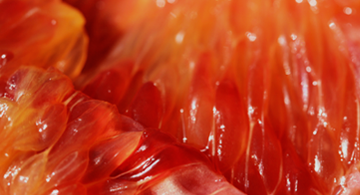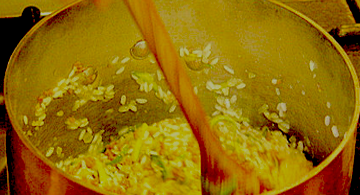
Portafoglio means wallet or billfold. Think of a man's billfold: the common shape is rectangular and flips open like a small book. That is a portafoglio, and is what we are going to do with a chicken breast. Butterfly it, then pound it, then stuff it. Using a restaurant technique for cooking, we'll sear it in a saute pan then finish in the oven.
This is a classic dish from Emilia-Romagna that can easily be made at home. When we cook in the restaurant and hear an order for "portafoglio", immediately its shape and form come to mind. How to cook it is exactly as appears in this recipe. The difference will be the stuffing. Change it according to season. Include cooked artichokes instead of asparagus. Sliced tomatoes are wonderful during the height of the season. In Autumn, saute mushrooms first to remove excess liquid then use in the stuffing.
When you select the cheese, make sure it has "meltability". Do not use fresh dairy products, latticini, such as mozzarella that is immersed in liquid unless you want your chicken swimming in a puddle at the end of cooking. Ditto ricotta since it tends to release liquid whey as well. It is best to choose a semi-hard aged cheese such as Swiss, Emmanthal, or Fontina Valle d' Aosta, for they possess the most luscious meltability. Although firmer in texture, you can make a portafoglio with turkey breast.
4 servings. Cooking time is 15 to 20 minutes.
4 chicken breasts, boneless, skinless (8 ounces or 225 g each)
Plastic wrap for pounding
4 thin slices baked ham
4 thin slices Swiss cheese
9 to 12 asparagus spears, pre-cooked as you prefer
All-purpose, plain, 00, or gluten-free flour
Salt to taste
Freshly ground pepper to taste
Extra-virgin olive oil
1/2 cup (120 ml) chicken broth
1. Preparing the Chicken: Trim off excess fat from the chicken breasts. Turn over so the top smooth side is down (the side formerly attached to the skin). The side that was previously attached to the rib cage is up and this is the side you will cut because it is easier to pound and stretch this side. Lengthwise, in the middle of each breast make a diagonal slice into – but not completely through – the center of the breast. Flip open, like a book or wallet. Place each breast between large sheets of plastic wrap then pound until the chicken is about 1/4-inch (6-mm) thick at most. (If you want to stop at this point, keep the chicken in the plastic wrap and store in the refrigerator until ready to use.)
 2. Classic Chicken Portafoglio – Stuffed and Floured Preparation: Curl back the top sheet of plastic wrap. Place the ham across the top of the chicken, then place the cheese on one half only. Lastly, place 3 to 4 pre-cooked asparagus spears on top of the cheese. Fold the ham over the asparagus spears and cheese and tuck in any overlapping ends. By doing this, the ham helps contain the cheese inside the chicken.
2. Classic Chicken Portafoglio – Stuffed and Floured Preparation: Curl back the top sheet of plastic wrap. Place the ham across the top of the chicken, then place the cheese on one half only. Lastly, place 3 to 4 pre-cooked asparagus spears on top of the cheese. Fold the ham over the asparagus spears and cheese and tuck in any overlapping ends. By doing this, the ham helps contain the cheese inside the chicken.
Now pick up the plastic wrap and lift up the other side of the chicken breast and fold it over the stuffing. Either meet the edges perfectly or leave it about 1/8-inch (3-mm) less at the top so the diner can see a little bit of the cheese and asparagus tips, as shown in the photo. (Usually we like to be able to identify the food on the plate before us, therefore leave just a hint of what the stuffing consists of. If completely sealed no one knows what is inside.) Firmly press this together. Sprinkle the flour on a large plate, and season it. Lightly coat the chicken breasts. (Immediately sear or the flour gets soggy.)
3. Cooking: Pre-heat the oven to 350° F/175° C/Gas Mark 4. In a large non-stick pan over medium heat, warm the olive oil. Place each floured, stuffed chicken breast in the pan and sear on each side for 1 to 2 minutes, to keep juices contained. The chicken looks white with a pale golden cast. Transfer the pan to the center of the pre-heated oven and cook for 10 to 15 minutes. Depending on actual weight and amount of stuffing, oven cooking time varies by a few minutes.

“Finishing in the oven” gives you a beautiful golden brown chicken that is juicy. It will contract and puff up almost double in thickness during this final stage, that is why it was best to pound it to 1/4-inch (6-mm) thickness.
Test for doneness by prodding with your fingertip, the chicken is firm and resists. Or use a meat thermometer inserted in the middle of the chicken, it should register 165° F/74° C. When done, remove the pan from the oven and transfer the chicken to warm serving plates.
4. Sauce: Using an oven mitt if the same pan remains quite hot, heat the pan on the cooktop over medium-high heat. Pour in the chicken broth and scrape the bottom of the pan to de-glaze and lift up caramelized juices. Reduce for only a minute or until a lovely juice-sauce forms, a little more than 1/4 cup (60 ml). Taste and season if needed. Spoon a small amount over each chicken breast then serve.







